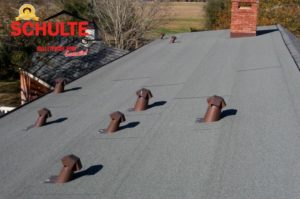 Low slope roofing, also known as flat roofing, is distinct for its horizontal or nearly horizontal design – which is a huge contrast to sloped roofs. The slight inclination of flat roofs allows water to run off to the side of a Conroe roof that has a gutter to keep water from pooling.
Low slope roofing, also known as flat roofing, is distinct for its horizontal or nearly horizontal design – which is a huge contrast to sloped roofs. The slight inclination of flat roofs allows water to run off to the side of a Conroe roof that has a gutter to keep water from pooling.
Traditional flat roofs use asphalt as a roofing material. Although asphalt BUR is a tough roofing material, it tends to become brittle from constant exposure to UV rays. This can lead to problems with leaks when ice dams form over the flat roof during the winter. This pooling of water has a tendency to seep in through small cracks along old asphalt roofs. Aside from leaking problems, early flat roofs also tend to sag and invert, especially when heavy layers of snow build up on them.
Although asphalt built-up roofs are still in common use, modern building techniques and modern roofing materials have helped overcome the problems associated with them and have introduced new modern flat roofs. Following is a list of the different types of flat roofs:
- Built Up – Built-Up Roofs, also known as BUR, either use coal tar pitch or asphalt. Built-up roofs are constructed using multiple layers of reinforcing plies and asphalt to form several layers of water- proofing. Commonly, asphalt is mixed with gravel to form a solid layer of roofing material.
- Modified Bitumen – This type of roofing material is pre-manufactured in the factory and delivered on-site in rolls. Such roofing material is a combination of modified asphalt or the coal tar system with a rubber layer. Before the bitumen membrane is applied, a built-up membrane under layer is applied to ensure a leak-proof seal. Modified bitumen can be: installed using heat; self-adhered; or mopped into place using hot bitumen.
- TerPolymer Olefins – This material is a fleeced-backed sheet membrane that can be adhered directly onto the insulation. The TerPolymer Olefins system is effective with or without a top system applied; however, it is best to have a top applied as it helps secure the layer in place and extends the life of the layer by protecting it from ultraviolet light damage.
- PVC – Polyvinyl Chloride or PVC is another popular roofing material used in flat roofs. PVC comes in rolls and is installed by fastening it directly onto the roof deck assembly. The seams are kept leak-proof either by heat welding each end of the sections together or by applying lap sealant. PVC is highly pliable, so it often requires fabric scrim as reinforcement. A top layer is not required with PVC roofing.
- EPDM – Ethylene Propylene Diene Monomer or EPDM is available in large sheets and can be laid directly over the insulation. The EPDM sheet can be installed loosely and secured with rocks or pavers to secure it in place. To ensure a water tight seal, the seams are adhered with sealants. An EPDM sheet is effective with or without a top layer applied over it.
Flat roofs may not be the most common type of modern Conroe roof or any other roof across the United States. It is beginning to gain popularity in modern home designs because of its many advantages over a more traditional approach. Following are some reasons to consider using a flat roof design:
- Space Efficiency – On lots where there is limited space, a flat roof is an advantageous design. Because flat roofs are almost horizontal, they do not unnecessarily use space. In fact, some homeowners even utilize flat roofs as gardens since they are a perfect means to be ecologically-friendly with a ‘green’ roof. The roof’s support structure must be sufficient to allow such a usage.
- Installation Ease – Compared to sloped roofs, flat roofs are easier to install since there is less of an accidental fall risk. Workers can complete the job more quickly than with a sloped roof.
- Low Maintenance – Keeping the roof clean and performing regular maintenance is also easier with a flat roof as the flat design allows for easier safe access.
- Cost Effective – Because flat roofs are easier to install, they are less expense than sloped roofs.
Implementing a flat roof design for a home can be very beneficial to a homeowner. The availability of modern roofing material makes flat roofs a viable option, especially for homes that have interior space shortage issues.
